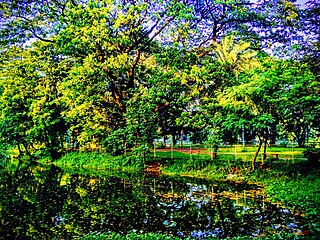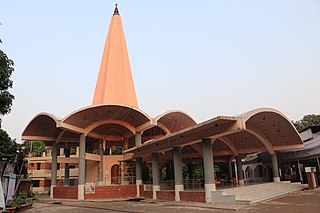Dhaka is the capital of Bangladesh, and one of top megacity of the world. It is also called City of Mosque (মসজিদের শহর). Here is a list of places of worship in Dhaka city.
Dhaka is the capital of Bangladesh, and one of top megacity of the world. It is also called City of Mosque (মসজিদের শহর). Here is a list of places of worship in Dhaka city.

Dhakeshwari National Temple is a Hindu temple in Dhaka, Bangladesh. It is state-owned, giving it the distinction of being Bangladesh's 'National Temple'. The name "Dhakeshwari" means "Goddess of Dhaka". Since the destruction of Ramna Kali Mandir in 1971 by the Pakistan Army during the Bangladesh Liberation War, the Dhakeshwari Temple has assumed status as the most important Hindu place of worship in Bangladesh. It is also the largest Hindu temple in Bangladesh. It is one of the Shakti Pithas, the goddess-centric shrines of the Indian Subcontinent.

Ramna Park is a large park and recreation area situated at the heart of Dhaka, the capital city of Bangladesh. This forested park with pond near its center is one of the most beautiful areas in Dhaka. Islamabad's diplomatic district is named Ramna as a tribute to Ramna Park. This dates from when Bangladesh was East Pakistan and the newly established capital of Pakistan, Islamabad, was divided into various sectors named after various provinces such as Shalimar depicting Punjab and Ramna Bengal.

Bardhaman, officially Bardhaman Sadar, is a city and municipality in the state of West Bengal, India. It is the headquarters of Purba Bardhaman district, having become a district capital during the period of British rule. Burdwan, an alternative name for the city, has remained in use since then.

Barguna is a district in the division of Barisal, in southern Bangladesh. Barguna subdivision was established in 1969 and promoted to a district on 28 February 1984.

Suhrawardy Udyan formerly known as Ramna Race Course ground is a national memorial located in Shahbagh, Dhaka. It is named after Huseyn Shaheed Suhrawardy. Originally it served as the military club of the British soldiers stationed in Dhaka. It was then called the Ramna Race Course and later Ramna Gymkhana. After the end of colonial rule, the place – sometimes referred to as Dhaka Race Course – was used for legal horse racing on Sundays.

Dhaka District is a district in central Bangladesh, and is the densest district in the nation. It is a part of the Dhaka Division. Dhaka, the capital of Bangladesh, and rests on the eastern banks of the Buriganga River which flows from the Turag to the southern part of the district. While Dhaka occupies only about a fifth of the area of Dhaka district, it is the economic, political and cultural centre of the district and the country. Dhaka District consists of Dhaka, Keraniganj, Nababganj, Dohar, Savar and Dhamrai upazila. Dhaka District is an administrative entity, and like many other cities, it does not cover the modern conurbation which is Greater Dhaka, which has spilled into neighbouring districts, nor does the conurbation cover the whole district, as there are rural areas within the district.

The Architecture of Bengal, which comprises the modern country of Bangladesh and the Indian states of West Bengal, Tripura and Assam's Barak Valley, has a long and rich history, blending indigenous elements from the Indian subcontinent, with influences from different parts of the world. Bengali architecture includes ancient urban architecture, religious architecture, rural vernacular architecture, colonial townhouses and country houses and modern urban styles. The bungalow style is a notable architectural export of Bengal. The corner towers of Bengali religious buildings were replicated in medieval Southeast Asia. Bengali curved roofs, suitable for the very heavy rains, were adopted into a distinct local style of Indo-Islamic architecture, and used decoratively elsewhere in north India in Mughal architecture.

The Ramna Kali Mandir is a temple in Dhaka that was originally built in the time of the Mughal Empire. It was also known as the "Ramna Kalibari". The temple is dedicated to the Hindu Goddess Kali.

Shahbagh is a major neighbourhood and a police precinct or thana in Dhaka, the capital and largest city of Bangladesh. It is also a major public transport hub. It is a junction between two contrasting sections of the city—Old Dhaka and New Dhaka—which lie, respectively, to its south and north. Developed in the 17th century during Mughal rule in Bengal, when Old Dhaka was the provincial capital and a centre of the flourishing muslin industry, it came to neglect and decay in early 19th century. In the mid-19th century, the Shahbagh area was developed as New Dhaka became a provincial centre of the British Raj, ending a century of decline brought on by the passing of Mughal rule.

Chawkbazar Shahi Mosque also known as Chawk Mosque is a mosque located in the Chowk Bazaar area in the old city of Dhaka, Bangladesh. The mosque was constructed in 1664 by Subahdar Shaista Khan. The mosque is known as the Shahi Mosque because it was founded by Subahdar Shaista Khan. The mosque is built above a raised platform. The three domed mosque above the platform, now transformed into a multi-storied structure was originally a copy of Shaista Khan's another three domed mosque at the Mitford Hospital compound near the Buriganga River. There are some square-shaped rooms built for the Imam and for students of the madrasa. Today the original building design has lost much of its original form through multiple renovations and extensions. The mosque is noted for having a rainbow minaret.
Ramna or Râmna may refer to:

Architecture of Bangladesh is intertwined with the architecture of the Bengal region and the broader Indian subcontinent. The architecture of Bangladesh has a long history and is rooted in Bangladesh's culture, religion and history. It has evolved over centuries and assimilated influences from social, religious and exotic communities. The architecture of Bangladesh bears a remarkable impact on the lifestyle, tradition and cultural life of Bangladeshi people. Bangladesh has many architectural relics and monuments dating back thousands of years.

Old Dhaka is a term used to refer to the historic old city of Dhaka, the capital of Bangladesh. It was founded in 1608 as Jahangirabad or Jahangirnagar, the capital of Mughal Province of Bengal and named after the Mughal emperor Jahangir. It is located on the banks of the Buriganga River. It was one of the largest and most prosperous cities of the subcontinent and the center of the worldwide muslin trade. The then Nawab of Bengal Murshid Quli Khan shifted the capital from Dhaka to Murshidabad in the early-18th century. With the rise of Calcutta during the British rule, Dhaka began to decline and came to be known as the "City of Magnificent Ruins". The British however began to develop the modern city from the mid-19th century.

The architecture of Dhaka is a confluence of many architectural styles. From the Sena temples built by Ballal Sen, to the Mughal architecture of the Mughals, to the Indo-Saracenic style of the colonial era, to 20th century steel and chrome of skyscrapers. Dhaka has a colonial core in the river port area, surrounded by progressively newer areas as one travels away from the Buriganga, punctuated with old temples, churches and mosques.
Ramna massacre was the massacre of Bengali Hindus who lived in the region around the Ramna Kali Temple in East Pakistan by the Pakistani army on the night of 27 March, 1971. It is estimated that around 250 Hindus were killed in the massacre.
The following is a timeline of the history of the city of Dhaka, Bangladesh.

Dhaka is the most populous city of Bangladesh and is characterized by its busy urban life with varied culture including many festivities, a variety of cuisine, an entertainment industry, shopping experiences and sites of interest. These nature of these activities mirrors the secular character of the city's population. Important holidays include Language Movement Day, Independence Day, Victory Day and Pahela Boishakh. Religious festivals include Eid ul-Fitr, Eid ul-Adha, Durga Puja, Buddha Purnima etc. Dhaka is known as the center of media and cinema of Bangladesh, housing many of Bangladesh's important academies. The culture of Dhaka is based on the culture of Bengal.

The Greater Jessore region predominantly includes the districts of Jessore, Jhenaidah, Narail and Magura in Bangladesh, as well as the Bangaon subdivision of India. Nestled close to the Sundarbans, the region experienced human settlement early on. It served as the capital city of the Samatata realm and passed through several Buddhist and Hindu kingdoms such as the Palas and Senas. Jessore was ruled by Khan Jahan Ali of Khalifatabad, under the Muslim Sultanate of Bengal, who is credited with establishing the Qasbah of Murali and urbanising the region through advancements in transportation and civilization. Jessore later came to be ruled by various chieftains such as Pratapaditya and became familiar to contemporary European travellers as Chandecan before being annexed to the Mughal Empire in the seventeenth century. By 1757, the British East India Company had dominated and started to establish themselves in the region. British rule lasted up until 1947, with Jessore coming under the Provisional Government of Bangladesh from 1971 onwards.